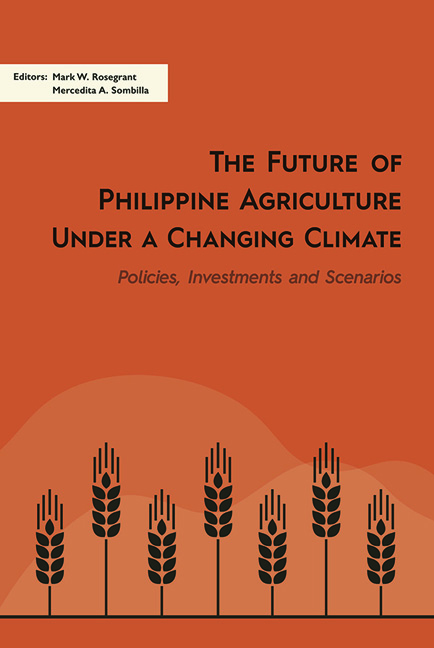Book contents
- Frontmatter
- Contents
- List of Tables
- List of Figures
- List of Appendices
- Preface
- Acknowledgements
- List of Contributors
- PART I Setting up the Scenarios: Current Status and Potential Impacts of Climate Change to Philippine Agriculture
- PART II Climate Change Adaptation Strategies and Sustainability of Philippine Agriculture
- 5 The Sustainability of Agricultural Growth
- 6 The Gendered Impacts of Climate Change
- 7 Adaptation and Mitigation Strategies
- 8 Risk Management and Coping Strategies
- PART III Investments and Supporting Policies to Alleviate Climate Change Impacts to Philippine Agriculture
- PART IV Conclusion
- Index
7 - Adaptation and Mitigation Strategies
from PART II - Climate Change Adaptation Strategies and Sustainability of Philippine Agriculture
Published online by Cambridge University Press: 29 May 2019
- Frontmatter
- Contents
- List of Tables
- List of Figures
- List of Appendices
- Preface
- Acknowledgements
- List of Contributors
- PART I Setting up the Scenarios: Current Status and Potential Impacts of Climate Change to Philippine Agriculture
- PART II Climate Change Adaptation Strategies and Sustainability of Philippine Agriculture
- 5 The Sustainability of Agricultural Growth
- 6 The Gendered Impacts of Climate Change
- 7 Adaptation and Mitigation Strategies
- 8 Risk Management and Coping Strategies
- PART III Investments and Supporting Policies to Alleviate Climate Change Impacts to Philippine Agriculture
- PART IV Conclusion
- Index
Summary
The United Nations Environment Programme has indicated that the most dangerous impacts of climate change could still be averted if rational and adequately financed adaptation and mitigation strategies are initiated to forestall disasters and migrations at unprecedented scales — but they must be applied immediately and aggressively. In the agricultural sector, adaptation and mitigation strategies primarily involve responses to higher temperatures, excessive precipitation, extreme weather events, rising sea levels, and the evolution of minor diseases and pest infestations into major ones. Resulting challenges include landslides, severe soil erosion, flooding, and drought, which in turn cause losses of crops, livestock, and fisheries; reductions in yields; shortages of water; and destruction of infrastructure (Table 7.1). Numerous strategies, technologies, and tools are available, but they need to be applied through coordinated and targeted approaches that respond to a complexity of locally specific conditions. Importantly, mainstreaming adaptation and mitigation strategies in agricultural development planning requires increased information and understanding about climate change and its implications, greater advocacy in the use of climate-smart practices, and intensified development and dissemination of risk-resilient technologies.
On this basis, this chapter examines the Philippines’ level of resilience to the adverse impacts of climate change, primarily focusing on agricultural policies, programmes, and activities currently in place. More specifically, the chapter assesses the alignment of climate change policies and priorities with the intended outcomes of the National Climate Change Action Plan (NCCAP) and Philippine Development Plan. The chapter presents evidence of the effectiveness of the country's agricultural adaptation and mitigation policies and initiatives, including recent trends in government budget allocations, and identifies constraints and challenges, proposing recommendations to overcome them. The primary methodology used is a review of the available literature, roadmaps, action plans, and project reports. Supporting information was also gathered through key informant interviews and consultations with key officials from the Philippine Department of Agriculture and local government agencies in Albay, Camarines Sur, Northern Samar, Davao City, and Benguet, among others. Some additional case study information was also collected for illustrative purposes.
THE CURRENT GOVERNMENT FRAMEWORK IN SUPPORT OF ADAPTATION AND MITIGATION
Recognizing the importance of managing greenhouse gases (GHGs), the Philippines has been proactive in responding to the negative impacts of climate change, including reducing atmospheric GHG emissions.
- Type
- Chapter
- Information
- The Future of Philippine Agriculture under a Changing ClimatePolicies, Investments and Scenarios, pp. 278 - 323Publisher: ISEAS–Yusof Ishak InstitutePrint publication year: 2018

